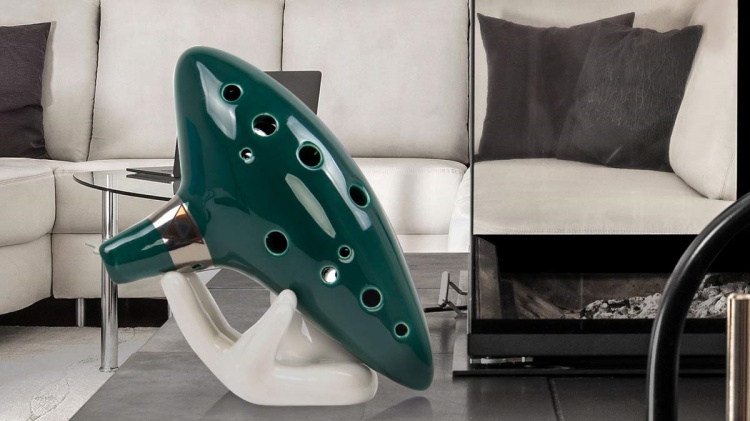The ocarina is an ancient and mesmerizing musical instrument capable of producing sweet, haunting tones. Though small, the ocarina requires practice and technique to play beautifully. For beginners learning the ocarina, developing fundamental skills and habits will start you on the path toward mastering this magical instrument.
In this comprehensive guide, we’ll explore core techniques for successfully playing the ocarina as a beginner. Follow these tips to make swift progress and bring your ocarina’s voice to life!

Selecting Your First Ocarina
Before you can begin playing, you’ll need to select an ocarina suited for beginners. Here’s what to look for in your first instrument:
- Ocarina Type – Go for a simple 6 to 10-hole pendant, inline, or English finger ocarina. Avoid more complex multi-chamber ocarinas for now.
- Key of C or G – Beginner ocarinas are commonly in the keys of C or G major, which work well with basic music theory instruction.
- Material – Ceramic, plastic or wood are all suitable. Focus on sound quality rather than appearance.
- Price – Inexpensive plastic ocarinas from $10-30 are fine while you’re learning. You can upgrade later.
Choosing the right starter ocarina will make learning much smoother and enjoyable. Don’t worry about professional features – just focus on fundamentals.
Mastering Your Embouchure
Embouchure refers to your mouth positioning as you blow into the ocarina to produce sound. Proper embouchure is crucial. Follow these tips:
- Form an Airtight Seal – Purse your lips so they seal tightly around the mouthpiece. No air should escape.
- Maintain Equal Pressure – Press your lips together evenly on all sides of the mouthpiece. Don’t favor the top or bottom lip.
- Find the Sweet Spot – Angle the ocarina down slightly and focus your airstream on the top area of the mouthpiece. Experiment to find the sweet spot.
- Use Your Cheeks – Puff out your cheeks firmly as you blow to build up air pressure. Don’t puff out so hard you strain.
- Moisten Your Lips – Keep your lips moist, as dry or cracked lips impair the airtight seal.
Practice embouchure until it becomes second nature. Refine it continually even as an advanced player. It’s the foundation for coaxing beautiful notes from the ocarina.
Mastering Breath Control
Proper breathing technique is also essential for playing the ocarina well:
- Inhale Through Your Mouth – Take slow, full breaths in through your mouth versus your nose when playing.
- Expand Your Diaphragm – On the inhale, feel your diaphragm pressing down to fill your lungs deeply from the bottom up.
- Exhale Completely – Release your breath steadily through the ocarina until you’ve fully emptied your lungs.
- Use Your Tongue – Use your tongue to articulate the start and end of notes. Say “Too” and “Too Koo” syllables.
- Find Optimal Air Speed – Blow firmly yet controlled. Adjust your exhale speed and pressure to produce clear notes without sputtering.
- Avoid Tensing Up – Keep your body relaxed as you breathe. Tension impairs airflow.
Deep diaphragmatic breathing takes practice but is vital for producing a rich, consistent sound.
Mastering Hand and Finger Technique
Playing the ocarina requires precise coordination between your hands:
- Keep Ocarina Level – Hold the ocarina straight horizontally with both hands to allow proper airflow.
- Use Left Hand Thumb – Your left thumb goes on the thumbhole on the back to support the ocarina.
- Finger Placement – Use soft finger pad tips versus flat fingertips to cover holes.
- Cover Holes Completely – Seal holes fully. Any air escape impairs note quality.
- Intonation – Adjust finger position slightly back or forward until the note sounds perfectly in tune.
- Finger Dexterity – Lift fingers up and down quickly and accurately between notes.
- Alternate Hand Use – Switch between hands smoothly so both get equal playing time.
- Minimize Motion – Keep extraneous hand motion to a minimum. Only lift fingers as needed.
With practice, your hands will grow accustomed to the ocarina until it feels like an extension of your body.
Reading and Following Sheet Music
Learning to read and follow sheet music opens up a world of songs to play on the ocarina:
- Note Names – Understand the note letter names (A, B, C) on the musical staff.
- Note Values – Learn the value of whole, half, quarter, and eighth notes.
- Key Signatures – Identify any sharps or flats in the key signature. These apply throughout.
- Time Signature – The top number indicates how many beats per measure. The bottom indicates the note value of one beat.
- Counting Rhythm – Count beats out loud to internalize the rhythm before you play. Tap your foot if it helps.
- Musical Expressiveness – Pay attention to dynamics, articulation, phrasing, and stylistic markings.
Don’t simply play the right notes – make the music come alive! Sheet music gives you a detailed roadmap.

Learning Scales and Exercises
Practicing essential scales and exercises systematically builds your ocarina skills:
- Scales – Start with basic C, G, D, F, and Bb major scales then progress to more complex scales. Focus on tone quality and intonation.
- Chromatic Scale – The chromatic scale spanning all twelve notes develops finger dexterity. Take it slow.
- Octave Leaps – Practice smoothly jumping between low and high notes to expand your range. Use octave leaps in popular songs.
- Articulations – Try tonguing, slurring, staccatos and other articulation exercises. Listen to the effect on your phrasing.
- Breathing Exercises – Do long tones, short tones, loud/soft tones, crescendos/decrescendos and other breath training.
- Alternating Fingers – Rapidly alternate different finger patterns like 1-2-3, 1-3-2, etc. to build coordination.
Scales and focused exercises train muscle memory far faster than only playing songs. But be sure to balance it with pieces you find fun and inspiring!
Learning to Improvise Melodies
One of the joys of instrumental mastery is being able to improvise your own melodies:
- Listen First – Improvise by ear, listening for combinations of notes that sound pleasing as you experiment.
- Outline Chords – Improvise based on the chord progression of a song by mainly playing chord tones.
- Start Simple – Begin improvising with very easy pentatonic and blues scale melodies over basic chords.
- Sing First, Play Later – Vocalize the melodies you want to play to get a sense of phrasing before trying them on Ocarina.
- Use Rhythmic Variety – Combine steady beats with syncopation, dotted notes, triplets, and swung rhythms.
- Build Tension and Release – Use tools like suspensions, sequences, and call-and-response phrases to give your improvised melodies direction.
- Record Yourself – Record improv sessions to review what kinds of ideas feel most natural. Analyze and learn from yourself.
Improvisation lets your musical soul sing freely! It develops faster than you expect if you commit to regular practice.
Playing Duets with Other Musicians
Playing duets with other instrumentalists or singers adds joy to your musical journey:
- Find a Duet Partner – Recruit a musical friend, teacher, or family member to learn compatible duets with.
- Balance Parts – Ensure both parts are equally rich and challenging. Avoid overly simple accompaniments.
- Start Slowly – Begin duets at a very slow tempo until you sync up perfectly. Only then increase speed.
- Listen Carefully – Keep your ears open to blend and match articulation, dynamics, and feeling with your partner.
- Trade Melodic Lines – Pass the melody back and forth to give both parts a chance to shine.
- Perform Together – Work towards polishing duets to a performance level rather than just casual play. Arrange a recital!
- Sight Read New Duets – Use duet sheet music books to explore an endless variety of pieces with your partner.
Playing duets develops your listening skills and musicality – skills that in turn make you a stronger solo player.
Staying Motivated Through Music You Love
Above all, be sure to play plenty of music you connect with emotionally to stay engaged:
- Folk Songs – Timeless folk melodies like Danny Boy, Shenandoah and Scarborough Fair suit the ocarina beautifully.
- Movie and Game Themes – Play memorable themes from your favorite soundtracks that inspire you.
- Pop Hits – Arrange simplified versions of current chart hits. The ocarina suits many ballads.
- Soothing Classics – Try classic pieces like Greensleeves, Ave Maria, and Canon in D to relax and unwind.
- Cultural Songs – Draw from your own cultural heritage for significant traditional tunes.
- Make Song Requests – Ask friends and family for song suggestions meaningful to them.
- Write Your Own Songs – Compose your own ocarina tunes! Record to preserve your creations.
Playing music that already brings you joy will make you eagerly come back to practice day after day.
Advanced Techniques to Strive For
Once you’ve mastered the basics, there are many advanced ocarina techniques to aspire to:
- Circular Breathing – Breathe in through the nose while exhaling out your mouth to play continuous passages.
- Multiphonics – Play two or more notes simultaneously by cross-fingering holes.
- Pitch Bends – Subtly adjust your embouchure mid-note to bend pitches up and down.
- Vibrato – Add expression by pulsing your breath to oscillate note pitch.
- Flutter Tonguing – Roll your “R”s as your tongue notes to achieve a fluttery effect.
- Altissimo – Expand your range to reach very high notes above the normal register.
- Glissando – Slide pitch smoothly between consecutive notes.
- Overblowing – Blow harder to jump to a higher octave of certain notes.
- Whistle Tones – Achieve ultra-high pitches by increasing your breath speed against the labium.
- Throttle Effect – Make a “wah wah” sound by opening and closing your throat as you sustain a note.
- Percussion – Beatbox percussive sounds against the ocarina’s body to accompany your playing.
With dedication, you can attain incredible expression and versatility on the ocarina! But focus on solid fundamentals first.

Conclusion
Learning the ocarina brings a magical new dimension to your life. Follow this guide of fundamental techniques and soon you’ll be expertly coaxing beautiful music from your ocarina.
Remember that becoming a true musician requires patience and persistence. Set reachable goals, practice regularly, and immerse yourself in music that inspires you. With an ocarina in hand, you hold an instrument of peace that can soothe souls and transport listeners.
Let your diligent practice unlock the ocarina’s mystical voice. Allow the ocarina to guide you on a lifelong journey of musical discovery.













